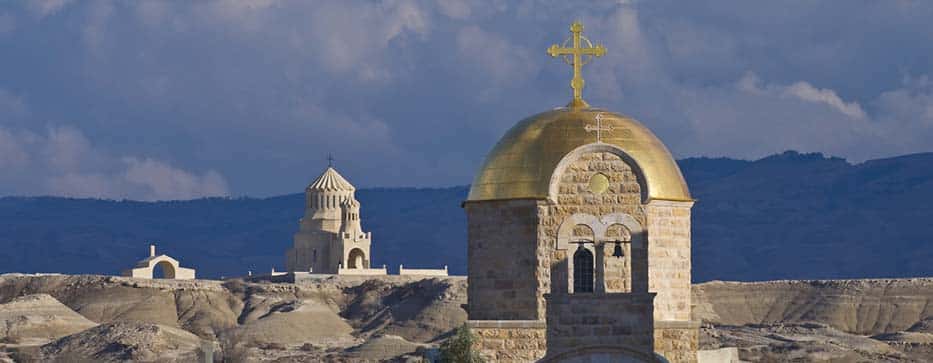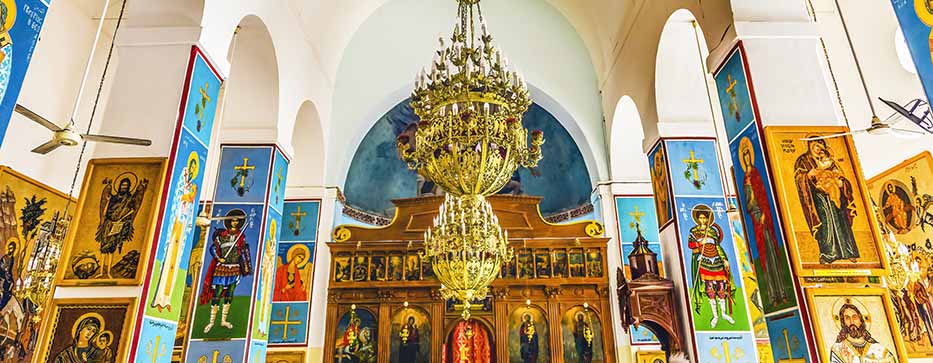For any traveler, the large number of Christian places in Jordan It may surprise. For a well-versed believer, not so much. There are many sacred spaces that this religion has on Jordanian soil. And the country, in a demonstration of tolerance towards other faiths (and aware of its tourism potential), has put them in value so that people from anywhere in the world can know them.
“Holy Land” is a somewhat generic concept used by Christianity to indicate the places where the episodes described in the Bible took place, both in the New and Old Testaments. But what is certain is that Jordan is part of that Holy Land, because here took place some of the most outstanding events, related in the holy scriptures.
This is due to the proximity of Jordan to other fundamental places for this religion, especially Jerusalem (from some points of the Jordanian Highlands, when the day is clear, you can see in the background with your eyes, without the need for binoculars).
The territory now occupied by Jordan was, millennia ago, a very advanced land, where some of the great social, economic and cultural changes of man took place. In this context, where writing, agriculture and other revolutions were already part of everyday life, the beliefs that shaped the three great monotheistic religions emerged: Judaism first, Christianity later and, finally, Islam.

Since Judaism and Christianity have much of their sacred story in common, both religions share veneration for certain places in Jordan, related to the prophets of the Torah and the Old Testament, until the birth of Jesus Christ.
In particular, the following can be highlighted, in chronological order of events:
We talk about all these places in depth on the
page dedicated to Judaism
in Jordan.
With the advent of Jesus, the course of events changes. The paths of Judaism and Christianity separate: and that of this second religion takes a direction that, on many occasions, brings to Jordan.
The first time that Jesus could have been in the lands of present-day Jordan goes back to the second flight that the Holy Family had to make: after returning from Egypt, where they took refuge from King Herod I the Great, they have to escape again, this time from his successor Archelaus and in the direction of Galilee. On their way, they would have stayed for a while in a cave, located perhaps in the city of Anjara, in the north of the country, near Ajloun. Today, the Sanctuary of the Virgin of the Mountain commemorates that fact.
It was also in Jordan that Christ’s entourage began to become aware of what his arrival implied, also known as Jesus of Nazareth or simply Jesus. Specifically, it was John the Baptist (or St. John the Baptist) who served as a prophet by baptizing his nephew in a special way. John, who was a Jewish preacher, performed the sacrament of baptism in streams (wadis) by the Jordan River, but for Jesus he chose a larger one, in the Jordan River itself. At that moment, the dove of the Holy Spirit descended from heaven to emphasize the presence of God, hearing a heavenly voice saying, “You are my dear son, my favorite” (Matthew 3:17 and John 1:32).
The exact place of baptism and its surroundings are preserved today and are the subject of visits and pilgrimages: it is called
Bethany Beyond the Jordan
. In it not only would have taken place the baptism of Jesus, but also another subsequent encounter, after Jesus had spent 40 days in the desert, tempted by Satan. And in that new encounter, John would have reaffirmed his prophecy, saying to his followers, among whom was Peter, “Behold the Lamb of God, who takes away the sin of the world” (John 1:29).
Another important Christian place in Jordan It also has as its protagonist John the Baptist. In this case, his tragic death: after reproving the marriage between King Herod Antipas and Herodias (daughter of his half-brother Aristobulus), he ended up imprisoned in the royal palace-castle and, at the instigation of Salome, was beheaded. That palace-fortress would be, in all likelihood, that of Machaerus, in the town of Mukawir, on top of a hill overlooking the
Dead Sea
.
The above would be the most prominent episodes on Jordanian soil during the years in which Jesus lived in the Holy Land. After that, the relentless persecution of his followers, including the Apostles, by the Roman authorities is a well-known story. But Christianity ends up being accepted and official in the Roman Empire in the third century. Since then, Romans first and their ‘heirs’ the Byzantines, later, are responsible for perpetuating the memory of these and other biblical events through temples and monuments.
Therefore, many of the Christian places in Jordan they are Byzantine churches, erected between the fifth and eighth centuries, mainly. Some churches that, to a large extent, were decorated with spectacular mosaics, especially as pavement, which denotes the wealth and prosperity of Christian society in those centuries. The best example of this is the mosaic map of Madaba, the oldest geographical representation of the Holy Land.
In the eighth century, the Arab conquest extends throughout the Jordanian territory and the construction of new temples is stopped, although in the first moments the coexistence between believers of both religions was maintained.
The twelfth century is also a key century and related to the Christian sites of Jordan and Israel. Until the previous century, what is now known as the Holy Land was under Fatimid Muslim rule, with a certain tolerance towards the holy places of Christianity. But in 1072, the Fatimids lost control of Palestine to the Seljuk Empire, with a different policy on the matter. Shortly afterwards the first crusades were promoted, which aimed at the conquest of Jerusalem for the Christian authorities.
The only successful Crusade was the first, which resulted in the creation of the Kingdom of Jerusalem. It spread over much of the territory of present-day Jordan: it did not go too far into the eastern desert, but the Crusaders (mainly from France) came to dominate a huge strip of territory from north to south, from the Sea of Galilee to the Gulf of Aqaba, especially from the reign of Baldwin I.
The result of all this were castles built or rebuilt by the Crusaders, inside which there was no lack of churches, in some cases of Byzantine origin. The fortresses of
Ajloun
,
Karak
or
Shobak
are good examples of this. At the end of that same century, the Muslim victories at the hands of Saladin’s Ayyubid troops reversed the situation and removed the dream that the kingdom of Jerusalem would survive in time, although later many other Crusades were organized.
The history of Christianity in Jordan has no relevant facts in the following centuries, since there were practically no concessions thereafter, especially since the sixteenth century, when the territory came under Ottoman rule.
But in the twentieth century there was a certain change: the fall of the Ottomans after the Arab Rebellion, the establishment of the British protectorate in Palestine and a growing international interest in archaeological discoveries in the Middle East favored projects to recover mosaics and Christian temples, as in Madaba and Mount Nebo.
Today, collaboration between Jordanian authorities and Christian spiritual leaders is palpable, especially since the signing of the peace treaty with Israel in 1994. This climate of stability has facilitated the visit to the country of popes (John Paul II, Benedict XVI, Francis I) and Orthodox patriarchs, and the better conservation of the Christian places in Jordan.

Today, virtually all tourist destinations in Jordan have churches among their list of attractions, a sign that Christianity was fully implanted in those centuries. This is a list of cities and places where important churches are located, and where Christianity is most alive in Jordan:
The Christian Places of Jordan They represent a great attraction for many travelers interested in religion. It is also for authentic pilgrims who want to feel the emotion of stopping at the exact points where centuries ago the most important characters of the Bible landed: Moses, Elijah, John the Baptist … and of course, Jesus.
Therefore, there are circuits of different duration that take the visitor to these places. The shortest, simplest and most common is the one that connects Madaba with Mount Nebo and Bethany Beyond the Jordan: not only are they beautiful and exciting places, but they are also very close to each other.
But those who wish to devote more time to their religious trip through Jordan can add any of the places mentioned above, which will provide a broader vision of the development of Christianity in Jordan: churches located in Roman sites, Crusader castles that exemplify the attempt to recover Jerusalem for the Christian authorities, etc.
And of course, it is also possible to combine the Christian places of Jordan with those located in Israel, where the level of emotion and devotion increases even more: Nazareth, St. John of Acre, Mount Tabor, Bethlehem and, above all, Jerusalem.
If you want to discover the entire Holy Land, including the Christian sites of Jordan and Israel, we recommend you put yourself in the hands of an agency specialized in this type of travel, such as Jordania Exclusiva. We have closed tour packages, with circuits that integrate the most representative sacred sites.
But if you wish, we can also configure a tailor-made program, with a longer or shorter duration than usual, and with a personalized itinerary to discover the Holy Land as you had always imagined it.